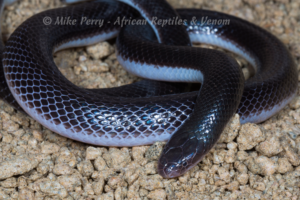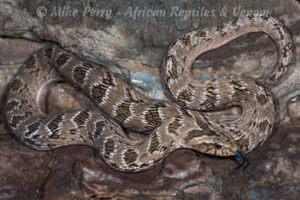DANGEROUS, BUT NOT DEADLY.
In this article we use the word dangerous in the context of snakes that regularly bite people and cause morbidity (tissue damage or systemic effects) but NOT mortality (death).
Only two species fall into this category, namely Night Adders and Stiletto Snakes.
Cytotoxic venoms cause “Painful Progressive Swelling” and can result in permanent tissue damage and tissue-loss due to necrosis. In rare cases, amputation of the affected digit or limb is indicated, especially in unmanaged bites with a secondary infection.
Stiletto Snakes
 The Stiletto Snake is found in the northern parts of South Africa. It ranges from the Kalahari regions of the Northern Cape and western Free State, most of Kwazulu-Natal and most of the old Transvaal provinces.
The Stiletto Snake is found in the northern parts of South Africa. It ranges from the Kalahari regions of the Northern Cape and western Free State, most of Kwazulu-Natal and most of the old Transvaal provinces.
The Stiletto Snake lives underground and emerges at night, especially after heavy summer rains. Bites are relatively common and happen when the snake is stood on at night. In many bite cases the snake is mistaken for a harmless snake and handled. The snake is generally small, slender, shiny and dark and may be mistaken for harmless burrowing snakes like blind or worm snakes.
Stiletto Snake bites result in severe pain and swelling, often with blistering. Bites carry the risk of necrosis and loss of tissue, but Stiletto snakebites are not deadly. Treatment is symptomatic at a medical facility. Antivenom is not effective and must NOT be used in Stiletto snake bites.
In conclusion, the Stiletto Snake is very dangerous, but not deadly.
Rhombic Night Adder
 The Rhombic Night Adder is found in the higher-rainfall eastern parts of South Africa. Their distribution begins around George in the Western Cape, through most of the Eastern Cape and KZN and most of the old Transvaal provinces except the border regions of Botswana and Zimbabwe. In the Mpumalanga Lowveld they are replaced by their sister species – the Snouted Night Adder – which has the same venom.
The Rhombic Night Adder is found in the higher-rainfall eastern parts of South Africa. Their distribution begins around George in the Western Cape, through most of the Eastern Cape and KZN and most of the old Transvaal provinces except the border regions of Botswana and Zimbabwe. In the Mpumalanga Lowveld they are replaced by their sister species – the Snouted Night Adder – which has the same venom.
Rhombic Night Adder bites are relatively common and not deadly. Bites are more likely to happen on the foot or ankle, during the day – as night adders are usually active during the day (not nocturnal as the name suggests). Bites result is pain (sometimes extreme pain) and swelling that subsides over about 3 days.
Bites often occur on snake enthusiasts who, knowing these snakes are not deadly, take the risk of handling these snakes.
Antivenom is NOT effective for Night adder bites. Bites can be treated symptomatically at a medical facility.
In conclusion, the Rhombic Night Adder is statistically dangerous, but not deadly.
Conclusion
It could be argued that the smaller adders, such as berg adders and horned adders are ‘Dangerous but not Deadly’, but very few bites are recorded. This makes them ‘hazardous’, but not statistically dangerous. The smaller adders mostly have cytotoxic venoms, but are not deadly. Bites result in the same symptoms as described below. The exception is the berg adder, which has cytotoxins as well as neurotoxins in its venom.
Not all dangerous snakes are deadly. Statistically, South Africa’s most dangerous snakes, are not deadly.
The few species causing deaths most often are those with strong neurotoxic venoms, mainly the Cape Cobra and Black Mamba. Bites from Cape Cobra and Black Mambas snakes have good outcomes if treated with antivenom promptly.
